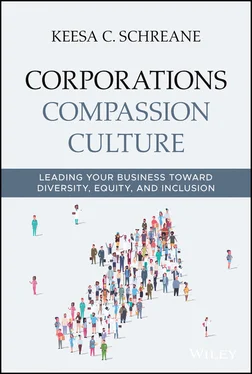The Black Codes, established during the Reconstruction era, involved granting Blacks certain freedoms such as buying and owning property, marrying, and making contracts and court testimonies (involving other Blacks only). But the central aim was to restrict Black labor. Penalties for breaking labor contracts included arrest, beatings, and forced labor. All-White police and state militia forces throughout the South doled out these harsh punishments.
The Black Codes exemplify the dangers of working-while-Black, or even attempting to do so, dating back to the late 19th century. In essence, these systems were created to reinstitutionalize freed people and the newly established Black workforce under the auspices of incarceration. The Black Codes give context into just how difficult it was for Blacks to enter the official paid workforce, even after emancipation from slavery. In Chapter 1, we talked about how White workers in the steel industry faced dangerous workplace conditions. But Black workers in the South dealt with an even more sinister reality.
Even after slavery Black workers had to figure out how to best advocate for themselves, because it wasn't clear that their work and their labor power would be respected or valued. Even the most basic idea of getting the wages that you earned at the end of the day was something that Black workers always had to worry about. All of those concerns have created a legacy about anecdotes about unfair wage practices and racism. All these have required Black people to be really vigilant in the workplace.
— Dr. Marcia Chatelain, associate professor, Department of History, American Studies Program at Georgetown University, and author of Franchise: The Golden Arches in Black America 2
Suspicion Well-Earned: The Freedman's Savings and Trust
These examples help explain the distrust people of color often feel toward their employers. But we can also look through the lens of consumers and investors—and, here again, people of color often feel suspicious of White corporate systems. That mistrust is well-earned, rooted in devastating events. Freedman's Savings and Trust Company provides a perfect example.
After slavery ended, the US government determined that former slaves needed to participate fully in workforce activities. They wanted this to go beyond basic food and shelter to include access to financial services as well.
On March 3, 1865, Congress established Freedman's Savings and Trust Company with the purpose of helping Blacks understand and leverage the financial services system. The company also focused on hiring and training Blacks to work there. The rationale for the bank was clear: large numbers of Black men had been on the payroll of the Union Army, and paid labor needs a means to see returns and access capital.
Over the years, Freedman's grew. Deposit amounts were small, generally from $5 to $50, but added up to millions as deposits poured in from thousands of Blacks eager to establish financial services access. During its existence, Freedman's Savings and Trust Company had 37 branches and more than 70,000 depositors and $57 million in deposits (adjusted for inflation). 3
Along with a beautiful headquarters in Lafayette Square in Washington, DC, dozens of branches began popping up around the country. Then the problems began. Some were unforeseen, such as the Panic of 1873, which caused yields on government securities to sharply decrease, thus reducing the return. The panic affected the entire economy and can't be laid at the feet of Freedman's.
But the same can't be said for the bank's poor management. Freedman's didn't operate with the same rigorous oversight and risk controls that exist in banking systems today. Questions about the prudence of sinking $200,000 into a building on Lafayette Street went unasked. Then, there was the revelation that a Freedman's board member, a White man named Henry Cooke, was siphoning funds from the bank to his own enterprise. The US Government saw the bank was headed downhill, with all this hard-earned money from former slaves riding shotgun.
Efforts to bring in Frederick Douglass to oversee the bank were too late. A post-reconstruction political environment and poor oversight took its toll. The bank remained operational until 1874. More than 61,000 depositors lost over $3 million. Little was recouped. 4
The creation of the Freedman's Savings and Trust Company in 1865 shows Blacks leveraging their wages to participate in the capital-building structure, as well as their trust in that financial corporate structure. Both their finances and their trust were exploited.
Caitlin Rosenthal is an assistant professor of history at UC Berkeley and the author of Accounting for Slavery: Masters and Management, which is a history of slaveholders' business practices. Using Freedman's as an example, she talks about the impact of distrust in the workplace between underrepresented people and mainstream cultures:
For Black capitalism to make a difference the capital actually has to be held by Black Americans. They have to be the owners and to be in these positions of power. If you can create a structure where the ownership of the capital and the control over the capital is in the community then I think that that's really powerful. 5
Unions and Black Workers: Friend or Foe?
Given the importance of labor unions to employee-employer relationships—including expectations about productivity, protection, and pay—unions have long been a part of the Black employees' path to higher levels of inclusion, equality, and decent pay. But the path to equality has been a rocky one. To consider just one example, White employees of the Georgia Railroad went on strike in 1909, demanding that Black employees, who were paid less, be replaced with White workers who would, solely based on race, be paid more. When the strike eventually ended up in federal arbitration, the White union lost. Why? Because it was decided that paying Blacks equal to Whites would undermine the entire purpose of hiring Black workers in the first place. It's worth noting that the union in this case, the Brotherhood of Locomotive Firemen and Enginemen, was not only a White-only union but also acted consciously to the detriment of Black workers.
This is far from the only time that “diversity” in the workplace has been used to set one group of workers against another. Caitlin Rosenthal, assistant professor at University of California at Berkeley and author of Accounting for Slavery: Masters and Management, put it in stark terms:
Railroad managers and owners made [the case] for diversity [in hiring], but the business case they made was that having a diverse workforce would allow them to divide workers against each other and have more control over them. They said, “oh, we need to hire people with different racial backgrounds, but we're going to use that as a strategic advantage to prevent them from unionizing.” So there are people who've made business cases for diversity before, and they aren't always ones that we would feel good about now. 6
Time and again, workers of color have discovered that diversity efforts are not always what they seem on the surface. History offers countless examples of this phenomenon. A 1907 report indicated that Black workers faced prejudice in trade unions and were permitted to work only where Blacks were highly concentrated so not to threaten White workers. 7 The point is, the unions that helped protect the mental, physical, and financial well-being of workers didn't cover Blacks.
The Black Experience in Agriculture
The union-dominated industrial jobs were not the only ones available to Blacks. As a matter of fact, national farm statistics show that the opportunities for economic mobility among Blacks were actually to be found in agriculture, a trend that peaked in the 1920s. At the time, there were almost 1 million Black farmers. (Today that number is down to only 1.3% or about 45,000 of the 3.4 million total farmers, of which 95% are White. 8 ) As the financial obstacles of the Great Depression took their toll on the farming industry, the New Deal legislation passed to assist White agricultural workers was not extended to Black ones. As James Gilbert Cassedy notes:
Читать дальше












